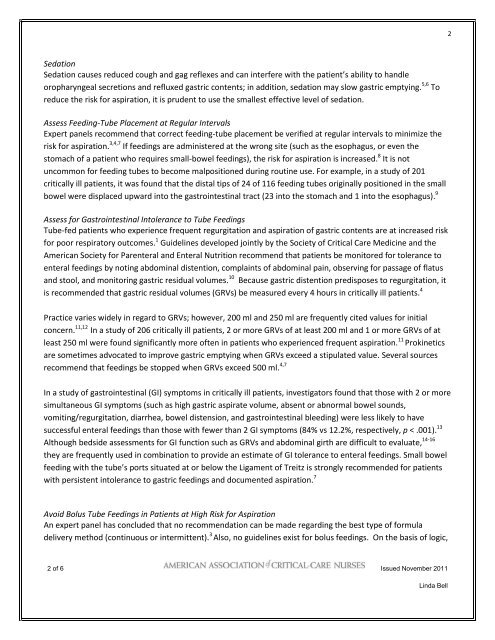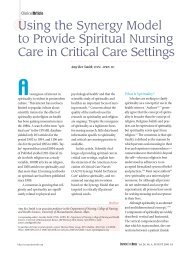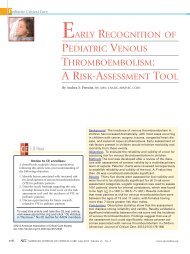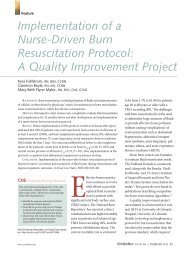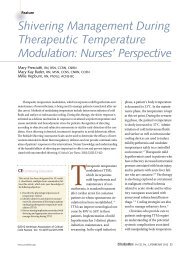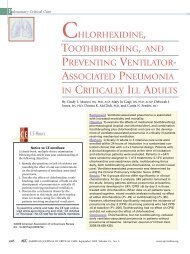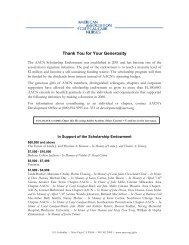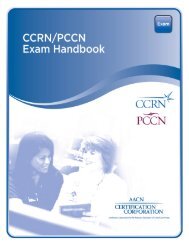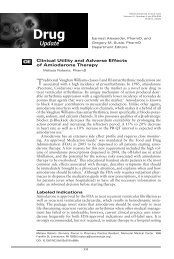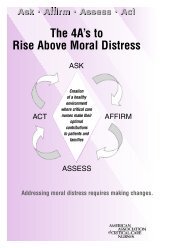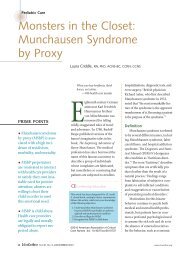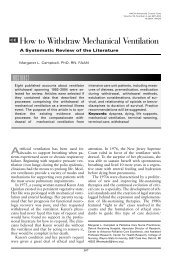Prevention of Aspiration Practice Alert - American Association of ...
Prevention of Aspiration Practice Alert - American Association of ...
Prevention of Aspiration Practice Alert - American Association of ...
Create successful ePaper yourself
Turn your PDF publications into a flip-book with our unique Google optimized e-Paper software.
Sedation<br />
Sedation causes reduced cough and gag reflexes and can interfere with the patient’s ability to handle<br />
oropharyngeal secretions and refluxed gastric contents; in addition, sedation may slow gastric emptying. 5,6 To<br />
reduce the risk for aspiration, it is prudent to use the smallest effective level <strong>of</strong> sedation.<br />
Assess Feeding-Tube Placement at Regular Intervals<br />
Expert panels recommend that correct feeding-tube placement be verified at regular intervals to minimize the<br />
risk for aspiration. 3,4,7 If feedings are administered at the wrong site (such as the esophagus, or even the<br />
stomach <strong>of</strong> a patient who requires small-bowel feedings), the risk for aspiration is increased. 8 It is not<br />
uncommon for feeding tubes to become malpositioned during routine use. For example, in a study <strong>of</strong> 201<br />
critically ill patients, it was found that the distal tips <strong>of</strong> 24 <strong>of</strong> 116 feeding tubes originally positioned in the small<br />
bowel were displaced upward into the gastrointestinal tract (23 into the stomach and 1 into the esophagus). 9<br />
Assess for Gastrointestinal Intolerance to Tube Feedings<br />
Tube-fed patients who experience frequent regurgitation and aspiration <strong>of</strong> gastric contents are at increased risk<br />
for poor respiratory outcomes. 1 Guidelines developed jointly by the Society <strong>of</strong> Critical Care Medicine and the<br />
<strong>American</strong> Society for Parenteral and Enteral Nutrition recommend that patients be monitored for tolerance to<br />
enteral feedings by noting abdominal distention, complaints <strong>of</strong> abdominal pain, observing for passage <strong>of</strong> flatus<br />
and stool, and monitoring gastric residual volumes. 10 Because gastric distention predisposes to regurgitation, it<br />
is recommended that gastric residual volumes (GRVs) be measured every 4 hours in critically ill patients. 4<br />
<strong>Practice</strong> varies widely in regard to GRVs; however, 200 ml and 250 ml are frequently cited values for initial<br />
concern. 11,12 In a study <strong>of</strong> 206 critically ill patients, 2 or more GRVs <strong>of</strong> at least 200 ml and 1 or more GRVs <strong>of</strong> at<br />
least 250 ml were found significantly more <strong>of</strong>ten in patients who experienced frequent aspiration. 11 Prokinetics<br />
are sometimes advocated to improve gastric emptying when GRVs exceed a stipulated value. Several sources<br />
recommend that feedings be stopped when GRVs exceed 500 ml. 4,7<br />
In a study <strong>of</strong> gastrointestinal (GI) symptoms in critically ill patients, investigators found that those with 2 or more<br />
simultaneous GI symptoms (such as high gastric aspirate volume, absent or abnormal bowel sounds,<br />
vomiting/regurgitation, diarrhea, bowel distension, and gastrointestinal bleeding) were less likely to have<br />
successful enteral feedings than those with fewer than 2 GI symptoms (84% vs 12.2%, respectively, p < .001). 13<br />
Although bedside assessments for GI function such as GRVs and abdominal girth are difficult to evaluate, 14-16<br />
they are frequently used in combination to provide an estimate <strong>of</strong> GI tolerance to enteral feedings. Small bowel<br />
feeding with the tube’s ports situated at or below the Ligament <strong>of</strong> Treitz is strongly recommended for patients<br />
with persistent intolerance to gastric feedings and documented aspiration. 7<br />
Avoid Bolus Tube Feedings in Patients at High Risk for <strong>Aspiration</strong><br />
An expert panel has concluded that no recommendation can be made regarding the best type <strong>of</strong> formula<br />
delivery method (continuous or intermittent). 3 Also, no guidelines exist for bolus feedings. On the basis <strong>of</strong> logic,<br />
2 <strong>of</strong> 6 Issued November 2011<br />
Linda Bell<br />
2


